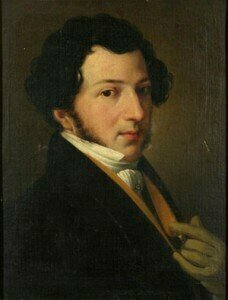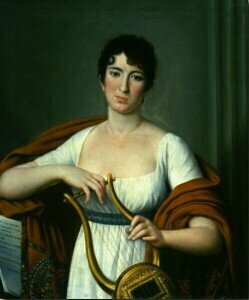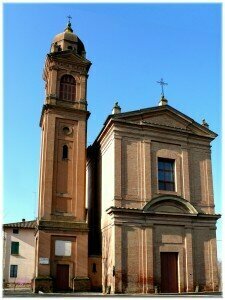
Giaochino Rossini , circa 1815
They probably first met in Bologna around 1815, and the union between Giaochino Rossini and Isabella Colbran was to become one of the most successful artistic alliances in the history of music. Rossini was a rising star when he was engaged by the impresario Domenico Barbaia to reside in Naples and to compose for its renowned opera houses. Barbaia was a drunkard and nearly illiterate loudmouth with a natural gift for seemingly endless self-promotion. He managed a stable of legendary opera singers and dancers, among them his mistress Isabella Colbran. The beautiful Spanish-born diva was the reigning prima donna and easily considered the finest coloratura soprano of her age. Colbran possessed a voice of great beauty, an extraordinary range of three octaves, and a technique of great virtuosity and astounding agility. The timbre of her voice was described as “sweet and mellow, with a rich middle register able to conjure touching lyricism,” and Rossini’s music specifically written for her suggests a perfect mastery of trills, half-trills, ascending and descending chromatic scales, and octave leaps.

Isabella Colbran
In 1815, Rossini composed the title role of “Elizabeth, Queen of England” specifically for the Spanish prima donna. Professional collaboration quickly translated into personal intimacy, and Rossini and Colbran became lovers. Over the coming years, Colbran became his muse and decisively shaped Rossini’s compositional art. Colbran was the daughter of the renowned violinist music teacher Juan Colbran, who was active at the Spanish court. He quickly identified the enormous musical potential of his daughter and resigned his position to support Isabella’s career. They departed for Paris and Italy, and by age twenty she had conquered the stages of Europe. And that included the Teatro di San Carlo in Naples, already home to a number of famous singers, including the castrato Farinelli. However, Isabella was not only famous for her voice, she was also a gifted composer who had written several collections of songs dedicated to the Queen of Spain and the Empress of Russia.
Isabella Colbran: 6 Petits airs Italiens
Castenaso
To complement Colbran’s talent, Barbaia signed Rossini under a seven-year contract. Already known as a composer of comedies, Rossini’s choice of subjects for his opera seria was greatly influenced by Colbran’s extraordinary talent for noble and dramatic roles. In all, Rossini composed seven operas for her, creating a number of powerful and vocally demanding roles. Colbran was at the height of her powers, and her performances proved immensely popular. After having lived together for almost seven years, it was time to legitimize the relationship. As such, the wedding took place on 16 March 1822 at the church of the “Beata Vergine del Pilar” in Castenaso, near Bologna. Since the happy event was scheduled during Lenten season, a special dispensation by Cardinal Oppizzoni was required for the ceremony to take place. And as expected, the celebrity couple became the toast of the European operatic scene.

Domenico Barbaia © Wikipedia
Paradoxically, the vocal demands of the roles created for her by Rossini probably contributed to the rapid deterioration of Colbran’s voice. For an engagement in Vienna and later Venice, Rossini composed
Semiramide. Once again, the title role was specifically written for Colbran, with Rossini designing the vocal part to disguise her failing vocal prowess. The opera proved highly successful, but her performances were considered disappointing. After a disastrous tour of England in 1824 Colbran retired from the stage at age 42. Although their professional life had been highly successful and profitable, the couple’s married life was not a happy one. Colbran had developed a debilitating gambling habit, and the extraordinary rise of Rossini’s career as a composer allowed him to expand into new theatres and new cities, particularly Paris and London. As such, Rossini engaged in a number of personal liaisons, above all with the courtesan and model Olympe Pélissier. Rossini and Colbran separated around 1830, and her health continued to decline. Rossini kept supporting her financially, and when Isabella died on 7 October 1845 she was buried in the Rossini family plot. It would certainly be misleading to look at Isabella Colbran exclusively through her relationship with Rossini. More than any other singer of her time, she influenced the Italian melodrama, inspiring a great number of composers. Rossini, for one, always credited her as the “greatest interpreter of his music.”







